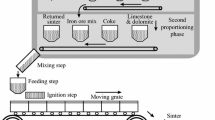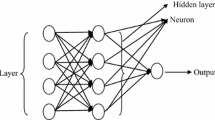Abstract
Based on the idea of fusing modeling, an integrated prediction model for sintering process was proposed. A framework for sulfur content prediction was established, which integrated multi modeling ways together, including mathematical model combined with neural network(NN), rule model based on empirical knowledge and modelchoosing coordinator. Via metallurgic mechanism analysis and material balance computation, a mathematical model calculated the sulfur content in agglomerate by the material balance equation with some parameters predicted by NN method. In the other model, the relationship between sulfur content and key factors was described in the form of expert rules. The model-choosing coordinator based on fuzzy logic was introduced to decide the weight of result of each model according to process conditions. The model was tested by industrial application data and produced a relatively satisfactory prediction error. The model also preferably reflected the varying tendency of sulfur content in agglomerate as the evidence of its prediction performance.
Similar content being viewed by others
References
WANG Ya-lin, GUI Wei-hua, CHEN Xiao-fang, et al. Neural network modeling for composition prediction of Pb-Zn sinter in imperial smelting process[A]. Proceedings of the Annual Chinese Automation Conference[C]. Derby, England, 1999: 21–24.
Efstathiou J. Expert Systems In Process Control[M]. Essex: Longman Scientific & Technical, 1989: 20–27.
WU Min, GUI Wei-hua. An expert control and fault diagnosis scheme for the leaching zinc process [J]. Control Theory & Applications, 2001, 18(6): 861–866.
Hagan M T, Demuth H B, Beale M H. Neural Network Design [M]. Boston: PWS Publishing Co, 1996: 5–17.
CHEN S, Billings S A. Neural networks for nonlinear dynamic system modeling and identification [J]. Int J Control, 1992, 56(2): 319–346.
WANG Ya-lin, GUI Wei-hua, YANG Chun-hua, WU Min. Adaptive supervised distributed neural networks and its industrial application [J]. Control and Decision (in Chinese), 2001, 16(5): 549–552.
WANG Hong-wei, MA Guang-fu. Nonlinear system modeling via fuzzy logic rules [J]. Control Theory & Applications(in Chinese), 2000, 17(3): 419–422.
DENG Hui, SUN Zen-qi, SUN Fu-chun. The fuzzy cluster identification algorithm [J]. Control Theory & Applications(in Chinese), 2001, 18(2): 171–175.
TANG Jia-fu, WANG Ding-wei. Fuzzy optimization theory and methodology: a survey [J]. Control Theory & Applications(in Chinese), 2000, 17(2): 159–164.
WU Min, Nakano M, SHE Jin-hua. A model-based expert control strategy using neural networks for the coal blending process in an iron and steel plant [J]. Expert Systems with Applications, 1999, 16(6): 271–281.
WANG Ya-lin, GUI Wei-hua, YANG Chun-hua, et al. A multi-objective optimization for the mixture ratio of Pb-Zn sintering process based on intelligent integrated model [A]. The Third Chinese World Congress on Intelligent Control and Intelligent Automation[C]. Hefei, China, 2000: 92–97.
Hiroshi T. Extracting rules from trained neural networks [J]. IEEE Transactions on Neural Network, 2000, 11(2): 377–389.
Medsker L R. Hybrid Neural Networks and Expert Systems[M]. Boston: Kluwer Academic Publisher, 1994: 31–54.
Hagan M T, Menhaj M. Training feed forward network with the Marquardt algorithm [J]. IEEE Trans. on neural network, 1994, 5(6): 989–993.
LI Jie, HAN Zheng-zhi. the learning error function of neural network and its generalization [J]. Control and Decision(in Chinese), 2000, 15(1): 95–97.
Author information
Authors and Affiliations
Additional information
Foundation item: The National 863 High Technology Program of China (No. 2001AA411040 & 2001AA414240)
Biography of the first author: CHEN Xiao-fang, doctoral candidate, born in 1975, majoring in process optimal control and modeling and genetic algorithm.
Rights and permissions
About this article
Cite this article
Chen, Xf., Gui, Wh., Wang, Yl. et al. An integrated modeling method for prediction of sulfur content in agglomerate. J Cent. South Univ. Technol. 10, 145–150 (2003). https://doi.org/10.1007/s11771-003-0057-z
Received:
Issue Date:
DOI: https://doi.org/10.1007/s11771-003-0057-z




